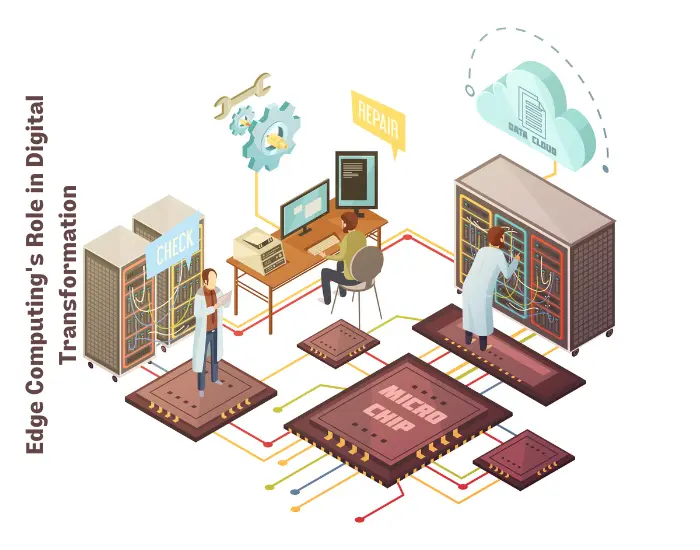Introduction
Digital transformation has been the mantra of modern enterprises, a powerful combination of technology and vision designed to redefine efficiency, agility, and customer experience. But as organizations climb the metaphorical heights of the cloud, they encounter a strange paradox: The farther they climb, the slower things get. Edge computing is a game-changing force rising from the foothills, poised to disrupt the established order and drive digital transformation to faster-than-light speeds.
Digital transformation depends heavily on data analysis. However, to enact significant changes, organizations frequently need to make substantial adjustments to the method of collecting, storing, or processing data. This is where edge computing comes into play.
As enterprise-oriented applications for edge computing continue to emerge, integration with digital transformation initiatives is becoming increasingly evident. Especially with technological advances such as machine learning and Internet of Things (IoT), edge computing is critical in amplifying potential business outcomes.
What is Edge Computing?

Edge computing is the changing shift in how data is processed and managed. Traditionally, data was centralized in large data centers, but edge computing takes a decentralized approach by bringing computation and storage closer to the data source. This proximity to the source enables faster processing, reduced latency, and enhanced real-time decision-making capabilities.
How Edge Computing Fuels Digital Transformation?
Below are some common ways in which digital transformation initiatives and edge computing come together to create greater business value:
Enhancing Connectivity
One of the fundamental aspects of digital transformation is connectivity. As the number of connected devices continues to soar, edge computing becomes indispensable in managing vast amounts of data generated by these devices. By processing data closer to where it is generated, edge computing minimizes the strain on network bandwidth and ensures a more efficient and responsive network infrastructure.
Real-Time Decision Making
In digital transformation, the ability to make informed decisions in real time is a strategic advantage. Edge computing enables organizations to process data instantaneously. It also lets them extract valuable insights and respond quickly to changing circumstances. This capability is particularly crucial in industries such as manufacturing, healthcare, and finance, where split-second decisions have profound implications.
Optimizing Workloads
Edge computing is instrumental in optimizing workloads by distributing computing resources across the network. This not only improves performance but also reduces the burden on centralized servers. The result is a more scalable and resilient infrastructure that can adapt to the dynamic demands of modern business operations.
Security and Privacy
Digital transformation brings with it a heightened focus on data security and privacy. Edge computing addresses these concerns by keeping sensitive data closer to its source, reducing the risk of data breaches during transit to centralized servers. This distributed approach enhances the overall security posture and ensures compliance with stringent data protection regulations.
Predictive Maintenance and Intelligent Processes
Many manufacturing and industrial companies are actively reaping the benefits of digital transformation at the edge. The momentum behind this early adoption comes from the need for enhanced safety, predictive maintenance, and autonomous processes. As a result, advanced algorithms for predictive maintenance and asset optimization have emerged, positively impacting key metrics across organizations. Factory operations teams achieve implementation by executing these algorithms on an on-site edge infrastructure, effectively reducing cloud latency and minimizing data movement.
Managing Costs While Providing Application Services, Whenever Needed
Data volumes are on a constant rise due to the growing number of devices, applications, and individuals requiring continuous connectivity. If all data must be sent to a central data center for processing, organizations may be compelled to expand their data center infrastructure to accommodate increasing demands, resulting in cost implications from both a capital expenditure (CapEx) and operational infrastructure (OpEx) standpoint. Additionally, the expenses related to backhauling data (i.e., bandwidth cost) become a consideration if all data is routed back to a central site.
New Customer Experience and Service Delivery Models
The banking, financial services, and insurance sectors are exploring edge computing to innovate and create new customer experiences and services leveraging connected devices, ranging from wearables to connected vehicles. Edge computing can further enhance user experiences through the integration of bots and voice-enabled intelligent assistants.
Support for Latency-Sensitive Applications
Identifying opportunities that are easily available, such as streaming media and real-time collaboration, often results in the most significant impact on your user base. One of the apparent and widely used applications of edge computing is in streaming high-definition media, spanning from online gaming to augmented reality (AR) applications for service technicians and real-time video streaming in next-generation sports stadiums. This requires edge computing to enable highly responsive applications without the need to send large amounts of data back to the cloud. Edge computing also proves invaluable in critical scenarios. Healthcare organizations, for example, can locally store and process data instead of relying on centralized cloud services. Consequently, clinicians gain more immediate access to vital medical data, such as MRI or CT scans, or information from ambulances or emergency rooms, facilitating faster diagnosis and treatments.
Improving User Experiences
The demand to enhance support for remote workplaces and ecosystems intensified during the COVID-19 pandemic. However, events of the past year have imposed a substantial strain on global network infrastructures. Business traffic has transitioned from dedicated business networks to shared residential circuits. The distance and route that network traffic must traverse to connect a remote worker to corporate network resources are likely to have undergone significant changes. These changes can often result in a suboptimal user experience, prompting businesses to explore alternative content delivery strategies. In many instances, the integration of edge-optimized resources can offer improved user experiences for employees, partners, and customers.
Coordinating and Safeguarding Distributed Assets and Devices
In the energy and utility sector, companies may derive value from implementing edge capabilities to facilitate real-time interventions for operational efficiency. Operating an oil rig, for instance, involves managing numerous legacy assets from different manufacturers. Edge-orchestration platforms can quickly connect and disconnect heterogeneous devices with varying interfaces and communicating protocols, enabling zero-touch and zero-trust management. In scenarios with remote operations and limited or no cloud connectivity, such as deep within a mine or in an agricultural field, edge computing can make real-time operational decisions based on local analysis of sensor data.
IoT sensors used in warehouses, factories, fields, and vehicles often adopt an asynchronous data model approach. With advancements in computing, connectivity, and functionality within these IoT form factors, many devices can now execute some computing operations independently, without the need for real-time interactions with other resources.
Conslusion
As businesses continue their journey towards digital transformation, the role of edge computing becomes increasingly important. Its ability to deliver faster processing, real-time decision-making, and enhanced security positions it as a catalyst for innovation. By embracing edge computing, organizations can unlock new possibilities, drive efficiency, and gain a competitive edge in the digital landscape. The future belongs to those who leverage the power of edge computing to navigate the complexities of the digital era.



